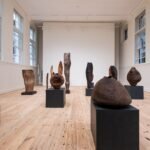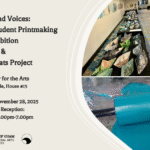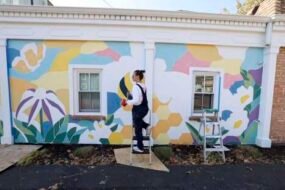
On Wednesday morning at Fifth and Market streets, on the grounds of Wilmington’s Bellamy Mansion Museum of History & Design Arts, the chilly fall air was filled with the sound of chattering third graders.
The schoolkids were on an annual field trip called Tar Heels Go Walking that’s a partnership between New Hanover County Schools and the Historic Wilmington Foundation. The sound of children happy for a day away from school mixed with another noise, one that hasn’t been heard at the Bellamy, which dates to 1861, in quite a few years: the sound of old paint being scraped off wooden siding.
For the first time since the late 1980s, and for the first time since the Bellamy became a full-time museum in 1994, the entire exterior of the massive historic mansion is getting a fresh coat of paint “from basement to belvedere,” said Leslie Randle-Morton, associate director of the museum. “It is really needed in terms of the building. They always say, the best way to make a building last longer is to keep it painted.”
Given the size of the Bellamy, which remains open for tours during the painting, that’s no small undertaking. The project, which is being done by Belville’s JBG Services, also involves the preservation and restoration of the Bellamy’s huge Corinthian columns and comes with a $120,000 price tag. That price doesn’t count the 240 gallons of paint, donated by Wilmington’s PPG Paint Store, that it will take to coat the Bellamy, said site manager Bob Lock.
The Bellamy held a fundraising oyster roast Sept. 28 and the scaffolding went up Oct. 3. The painting is on track to be done by the end of the month.
The work might’ve been done sooner, Randle-Morton said, but for some unexpected guests. Honey bees had built hives in five of the Bellamy’s massive columns.
“We were told they’ve probably been there for generations,” Randle-Morton said. “I don’t know if it’s genetic memory or what. They’re 25 feet up, so they weren’t bothering anybody.”
Still, the bees weren’t doing the house any favors and had to be relocated.
“It’s the only real delay with this project,” she said. “It’s not been the weather. It’s not been the scaffolding. It’s been the bees.”
Randle-Morton said Wilmington beekeeper Johnny Dickerson brought in a 40-foot ladder, used smoke to slow the bees down, then used a special vacuum to suck them up unharmed. He then took the hives out to his property in Kings Grant where they’re making honey right now.
One reason the Bellamy’s exterior was essentially painted piecemeal over the past 35 years, Randle-Morton said, is because, for more than a decade, the museum was focused on a $500,000 renovation of its historic slave quarters, which now houses offices, a visitor’s center and a gift shop.
Then, in 2018, Hurricane Florence hit, ripping off the roof of the Bellamy’s belvedere and pouring water all the way into the basement. Extensive repairs were required for the floors and the plaster walls. Brick piers supporting the massive porch had to be replaced, and one massive column was nearly destroyed but was able to be repaired.
The museum was able to obtain a federal grant earmarked for hurricane relief, but that didn’t come through until earlier this year, Randle-Morton said.
Historically, the Bellamy has been painted white, which in the South is a color freighted with history. But while painting the house white is historically accurate, the museum also takes pains not to whitewash the house’s history.
Scholarly essays have been written on how the choice to paint many antebellum Southern mansions white was a not-so-subtle reinforcement of white supremacy. It’s no secret that the Bellamys were avowed white supremacists who took the side of the Confederacy and, later, were directly involved in the Wilmington coup and massacre of 1898, during which dozens of Wilmington Black people were murdered.
Randle-Morton and the museum acknowledge all of this, and the museum has done extensive work over the years to acknowledge the contributions of Black laborers and artisans, many of them enslaved, who built the house, and who lived in the servants’ quarters.
As for the paint itself, anyone who’s been to a paint store recently knows there are dozens, if not hundreds, shades of white. Judging by old paint samples scraped off the building, Randle-Morton said, the original color might’ve been a limestone, or a “dirty white.”
“But it’s really guesswork,” she said, and the bright white picked by museum director Gareth Evans matches the Greek revival style of the house, with green shutters providing a little color.
The first known picture of the house, taken in 1873, shows the brick piers supporting the porch painted white, but it’s difficult to tell in a black and white photo whether darker areas on the house were shadows or a darker color.
Randle-Morton shows a picture from 1962, when the house had begun to fall into disrepair and the front of the house was painted white while the sides were left unpainted. She said the last time the house got a full exterior paint job was in 1989, just before the Bellamy was bought by the nonprofit Preservation North Carolina, which maintains the house as a stewardship property.
For most of the museum’s history, pains were taken to restore the house to its original, 1861 appearance.
“We interpret the house from many periods now,” Randle-Morton said. Both inside and out, different rooms and areas reflect different eras, “Almost like you’re walking through time.”











